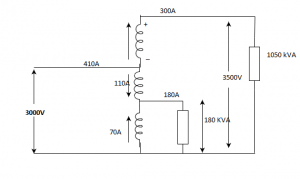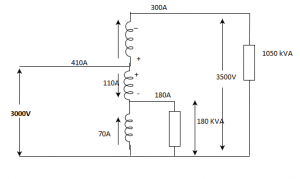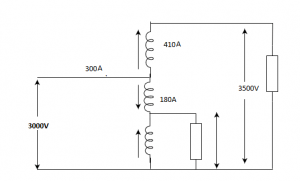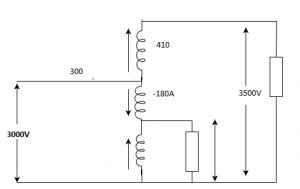This set of Electrical Machines Problems focuses on “Parallel Operation of Single Phase Transformers”.
1. A 2000/1000/500 three winding transformer is to be used as auto transformer with supply of 3000 V. Two loads of 1050 kVA at 3500V, and other one at 180 kVA at 1000V. The circuit representing the mentioned application is?
a) 
b) 
c) 
d)
View Answer
Explanation: Current due to load of 1050 kVA = 1050*1000/3500 = 300A
Current due to 180 kVA = 180*1000/1000 = 180A.
2. Transformer operating in parallel will share a common load in the best possible manner if ____________
a) leakage impedances are proportional to their kVA rating
b) pu leakage impedances are equal
c) leakage impedances are equal
d) any of the mentioned
View Answer
Explanation: For same pu leakage impedance, parallel operation of transformers become feasible.
3. A 2000/1000/500 three winding transformer is to be used as auto transformer with supply of 3000 V. Two loads of 1050 kVA at 3500V and other one at 180 kVA at 1000V. The total kVA supplied will be?
a) 1230 kVA
b) 1440 kVA
c) 1680 kVA
d) 1150 kVA
View Answer
Explanation: Total kVA = 1050+180 = 1230 kVA.
4. Which if the conditions is must be fulfilled for satisfactory parallel operation of transformers?
a) Same voltage ratio
b) Leakage impedances should be inversely proportional to kVA of the transformer
c) Same pu impedance
d) Correct polarity
View Answer
Explanation: out of all, polarity must be correct for the connected transformers.
5. Which of the following is the correct matching made for the harmonics and the associated harmonic component?
A. Positive sequence components - 5th harmonic component B. Negative sequence components - 7th harmonic component C. Zero sequence components - 3rd harmonic component
a) A, B, C
b) C
c) A, B
d) B, C
View Answer
Explanation: 3m-1 phases are displaced 120° in opposite and (3m+1) in the same direction as the fundamental. Here ‘m’ is even integer. So 5th harmonic is in negative sequence and 7th harmonic component in positive sequence.
6. Two single phase transformers A and B are operating in parallel having same impedance. But the x/r ratio of them are not equal. Then total kVA output of the output will be ___________
a) less than sum of kVA of A and B
b) more than sum of kVA of A and B
c) equal to sum of kVA of A and B
d) any of the mentioned
View Answer
Explanation: As the leakage reactances are not same for both the transformers, then Ia < I2 and Ib < I/2.
So the kVA will also be less than sum of individual A and B.
7. Two single phase transformers A and B are operating in parallel having same impedance. But the x/r ratio of them are not equal and xa > xb. Then?
a) A has poorer pf than B
b) B has poorer pf than B
c) lesser power factor angle
d) both operate at same power factor
View Answer
Explanation: As xa > xb, leakage impedance angle of A will be more than that of B, so lesser power factor.
8. Two single phase transformers A and B are operating in parallel having different impedance and identical x/r ratio. Then?
a) A has poorer pf than B
b) B has poorer pf than B
c) lesser power factor angle
d) both operate at same power factor
View Answer
Explanation: As the x/r is same, this supports that they should have same leakage impedance angles.
9. Two single phase transformers A and B are operating in parallel having different impedance and identical x/r ratio. Also impedance of A is more than that of B, then A ___________
a) shares lesser kVA
b) share more kVA
c) equal kVA as of B
d) total kVA
View Answer
Explanation: Given that, za is more than zb, so Ia will be lesser than Ib, With Ea = Eb, kVA(A) shared by A will more than kVA(B).
10. Two single phase transformers A and B are operating in parallel having different impedance and identical x/r ratio. Also impedance of A is more than that of B, then?
a) Za/Zb = Sb/Sa
b) Za/Zb = Sa/Sb
c) Za/Zb = 1
d) Za/Zb = (Sb/Sa)2
View Answer
Explanation: Leakage impedance in ‘ohms’ are inverse ratio of their respective kVA ratings.
11. Two single phase transformers A and B are operating in parallel having different impedance and identical x/r ratio. Impedance of A is Za and impedance of B is Zb, both sharing a load of Sl. Then the load shared by transformer A is?
a) Sl*(Zb/(Za+Zb))
b) Sl*(Za/(Za+Zb))
c) Sl*(Zb*Za/(Za+Zb))
d) Sl*(Zb+Za/Zb))
View Answer
Explanation: The load sharing is based on the inverse of the kVA rating.
12. Two single phase transformers A and B are operating in parallel having different impedance and identical x/r ratio. Impedance of A is Za and impedance of B is Zb, both sharing a load of Sl. Then the load shared by transformer B is?
a) Sl*(Zb/(Za+Zb))
b) Sl*(Za/(Za+Zb))
c) Sl*(Zb*Za/(Za+Zb))
d) Sl*(Zb+Za/Zb))
View Answer
Explanation: The load sharing is based on the inverse of the kVA rating.
13. Operating transformers in parallel gives the advantage of ___________
a) reliable loading
b) increased capacity of power system
c) reducing the capacity of substation
d) all of the mentioned
View Answer
Explanation: All are advantages of having parallel connection of transformers.
14. Which of the following is a shortcoming for using parallel connected transformers?
I. Reliable loading II. Increased capacity of power system III. Reducing the capacity of substation
a) I, II, III
b) I, II
c) I, III
d) None of the mentioned
View Answer
Explanation: All of the mentioned are advantages for using parallel connected transformers.
15. In three phase supply, the voltage phases are displaced by ________ and in two phase by ___________
a) 120°, 90°
b) 180°, 90°
c) 120, 120°
d) 120°, 180°
View Answer
Explanation: Displacement angle for m-phase system is 2*pi/m.
16. For a delta-star three phase transformer, if the transformation ratio is ‘x:1’, then how much percent of output will be improved?
a) 73%
b) 57%
c) 173%
d) 157%
View Answer
Explanation: Line voltage in the output will be (1.73*V/x), so the additional voltage will be (173-100/100)*100% = 73%.
17. For a star-delta three phase transformer, if the transformation ratio is ‘x:1’, then how much percent of output will be?
a) 73%
b) 57%
c) 173%
d) 157%
View Answer
Explanation: Line voltage in the output will be (V/1.73*x).
18. Identify the correct order for the voltage transformation for the three-phase transformers.
a) D-Y > D-D = Y-Y > Y-D
b) D-Y > D-D > Y-Y > Y-D
c) D-Y > D-D = Y-Y < Y-D
d) D-Y > D-D < Y-Y < Y-D
View Answer
Explanation: Delta to star has maximum(173%) voltage transformation while star to delta is least(57%). Y-Y and D-D have deviation of voltage levels.
Sanfoundry Global Education & Learning Series – Electrical Machines.
To practice all areas of Electrical Machines Problems, here is complete set of 1000+ Multiple Choice Questions and Answers.
If you find a mistake in question / option / answer, kindly take a screenshot and email to [email protected]
- Practice Electrical Engineering MCQs
- Check Electrical & Electronics Engineering Books
- Apply for Electrical Engineering Internship
- Apply for Electrical & Electronics Engineering Internship
- Check Electrical Machines Books
